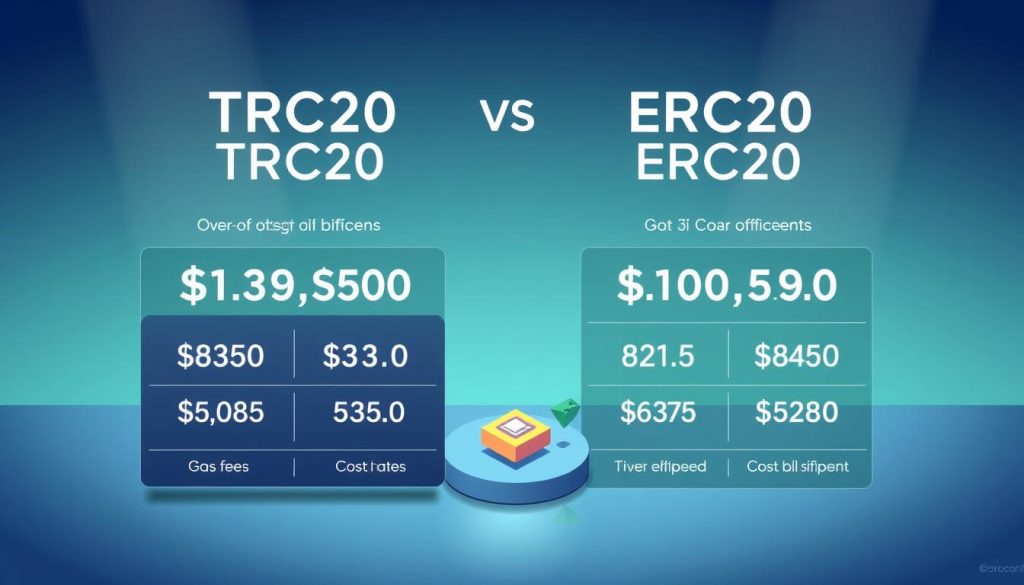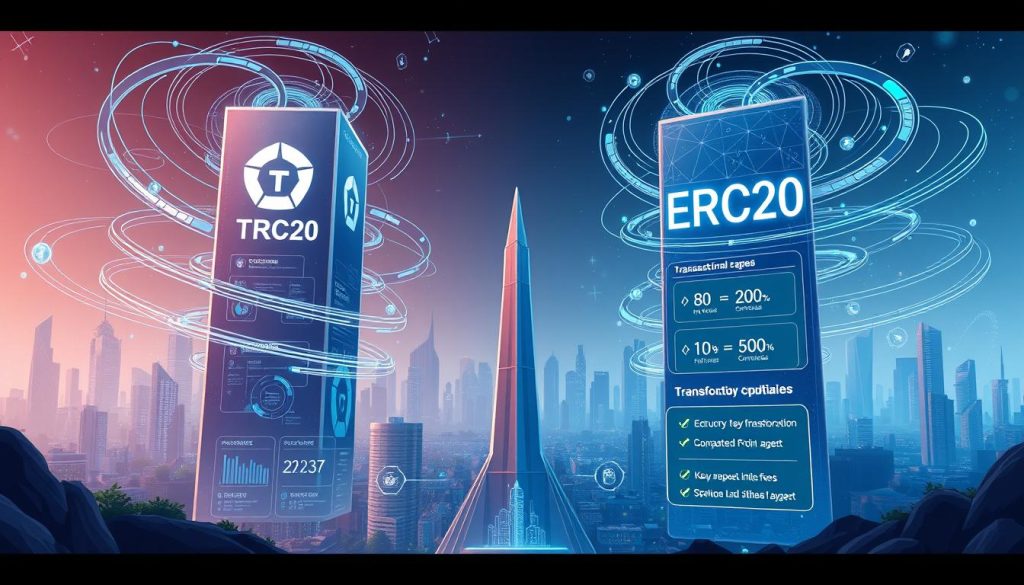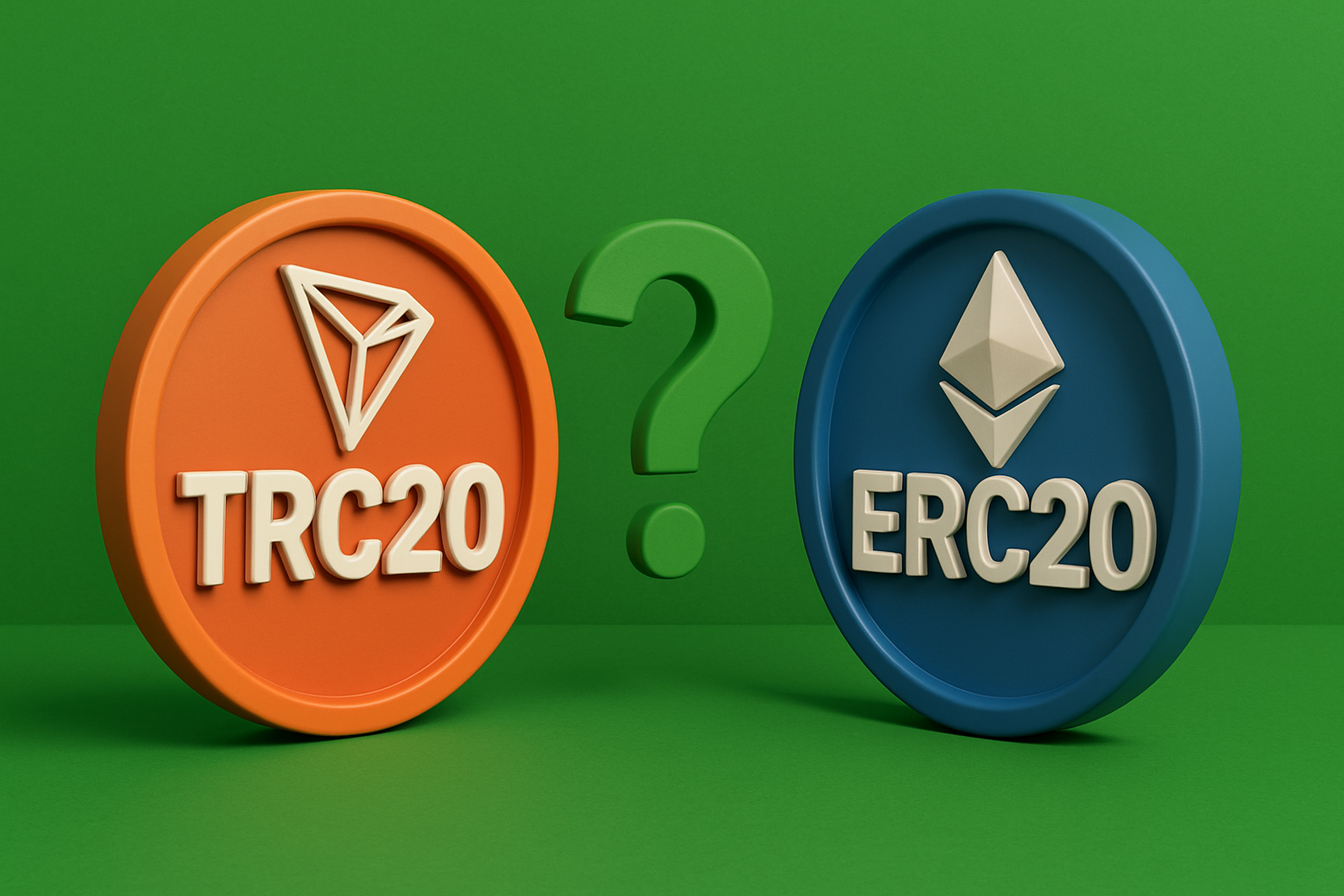Understanding token standards is critical for navigating the crypto landscape. These protocols dictate how digital assets operate on blockchain networks, influencing everything from transaction costs to processing speeds. While they share core functionalities, differences in their underlying architectures create unique trade-offs for users.
The TRC20 and ERC20 frameworks power popular stablecoins like USDT but function on separate ecosystems. One thrives on Ethereum’s established infrastructure, while the other leverages TRON’s high-speed network. These distinctions directly affect wallet compatibility, cross-chain transfers, and operational costs.
For traders and developers, choosing between these standards impacts efficiency and scalability. Transaction fees can vary dramatically depending on network congestion, and settlement times influence real-world usability. Even institutional investors must weigh these factors when managing large-scale crypto operations.
Key Takeaways
- Token standards define how digital assets function on specific blockchain networks
- Transaction speeds and fees differ significantly between protocols
- Both standards support major stablecoins but require compatible wallets
- Network choice affects scalability for developers and businesses
- Blockchain architecture determines energy efficiency and security features
Introduction to TRC20 and ERC20 Token Standards
Token standards form the backbone of cryptocurrency interoperability. These technical rules govern how digital assets behave across blockchain ecosystems, ensuring seamless interactions between wallets and exchanges. Without such frameworks, decentralized networks couldn’t maintain consistency or security.
Understanding the Basics
The ERC20 protocol revolutionized blockchain development when Ethereum introduced it in 2015. This system allows developers to create tradable assets like USDT and utility tokens with predefined smart contract functions. Over 500,000 ERC20-compliant assets now operate on the Ethereum blockchain.
Tron Network launched its TRC20 standard in 2018 to optimize transaction throughput. Designed for speed, this protocol processes transactions in seconds compared to Ethereum’s minute-long confirmations. Major stablecoins like USDT-TRC20 utilize this framework for high-volume transfers.
| Feature | ERC20 Standard | TRC20 Standard |
|---|---|---|
| Launch Year | 2015 | 2018 |
| Primary Network | Ethereum | Tron |
| Popular Tokens | USDT, SHIB | USDT, TRX |
Relevance in Today’s Crypto Market
Both standards dominate stablecoin transactions, handling billions in daily volume. ERC20 tokens maintain strong DeFi integration through Ethereum’s ecosystem, while TRC20 assets excel in payment systems requiring instant settlements.
Market data shows USDT exists predominantly as ERC20 and TRC20 tokens. This dual presence lets users choose between Ethereum’s security and Tron Network’s cost efficiency. Developers continue building on both standards due to their established user bases and technical reliability.
Blockchain Technology Underpinning TRC20 and ERC20
The engines driving modern token standards reveal why blockchain choices matter. Distinct architectures determine how assets handle transfers, security, and growth. Two systems dominate this space: Ethereum’s battle-tested framework and Tron’s speed-optimized protocol.
Ethereum Network Fundamentals
Ethereum’s proof-of-stake consensus powers its virtual machine (EVM), the backbone for token operations. This system prioritizes security through decentralized validation, with over 1 million validators securing transactions. The EVM executes complex smart contracts, enabling features like automated interest payments for DeFi tokens.
Block creation occurs every 12 seconds, balancing speed with network stability. This rhythm supports 15-45 transactions per second, suitable for applications needing ironclad security. Major financial institutions favor this architecture for its audit trails and regulatory compliance features.
Tron Network Advantages
Tron’s delegated proof-of-stake model uses 27 super representatives to validate blocks in 3-second intervals. This design pushes throughput to 2,000 transactions per second – ideal for micropayments and high-volume transfers. The Tron Virtual Machine (TVM) maintains compatibility with Ethereum tools while reducing operational costs.
| Feature | Ethereum Network | Tron Network |
|---|---|---|
| Block Time | 12 seconds | 3 seconds |
| Transactions/Second | 15-45 | 2,000+ |
| Consensus Model | Proof-of-Stake | Delegated Proof-of-Stake |
| Primary Use Case | Smart Contracts | High-Speed Payments |
While Ethereum focuses on decentralization, Tron optimizes for rapid settlement. This fundamental difference shapes how developers build financial tools versus consumer payment solutions. Both networks continue evolving to address scalability challenges in their unique ways.
Performance Comparison: Transaction Speed and Scalability
Transaction velocity separates contenders from pretenders in blockchain efficiency. While both protocols facilitate value transfers, their operational capacities diverge sharply under stress tests. Real-world performance metrics expose critical differences for traders and developers.
Speed and Throughput Analysis
The Tron blockchain processes 2,000-2,500 transactions per second (TPS) with 1-3 second confirmations. This throughput eclipses Ethereum’s base layer, which handles 15-30 TPS with 10-20 second settlement times. Tron’s delegated proof-of-stake consensus enables rapid validation through 27 super representatives.
Ethereum’s proof-of-stake model prioritizes security over speed. Its global validator network creates inherent latency, though upcoming upgrades aim to boost capacity. Current transaction speeds suffice for most DeFi applications but strain during peak demand.
Impact of Network Congestion
Ethereum transactions can take minutes during DeFi protocol launches or NFT drops. Gas fees spike exponentially, creating unpredictable costs. Tron maintains consistent performance under load, with fees rarely exceeding $0.01 per transfer.
Scalability solutions reshape these dynamics. Ethereum’s Layer 2 networks like Arbitrum process 40,000 TPS off-chain. Tron counters with continuous protocol optimizations, recently increasing block size by 50% to accommodate growth.
Cost Analysis: Transaction Fees and Gas Fees
Financial efficiency separates blockchain protocols in real-world applications. Transfer costs vary dramatically between networks, directly impacting user experience and operational budgets. This breakdown reveals why fee structures matter for both casual traders and institutional players.

Fee Structure on Ethereum vs. Tron
Ethereum’s gas fee model creates unpredictable costs. Users bid for block space during network congestion, causing prices to spike. Recent data shows transfers exceeding $15 when DeFi activity peaks.
Tron employs energy credits and bandwidth points to stabilize costs. This system caps fees at $0.01-$0.50 regardless of transaction volume. Stablecoin transfers demonstrate this disparity:
| Metric | Ethereum | Tron |
|---|---|---|
| Average Fee | $1-$3 | $0.01-$0.10 |
| Peak Fee | $15+ | $0.50 |
| Fee Determinants | Network Demand | Fixed Rates |
Three factors drive Ethereum’s higher costs:
- Proof-of-stake validation complexity
- Smart contract execution overhead
- Global validator coordination delays
Tron’s delegated consensus model bypasses these hurdles. Its 27-node system processes payments faster than traditional banking networks. For high-frequency traders, these savings compound significantly over time.
Network Compatibility and Ecosystem Integration
Digital asset ecosystems thrive on interconnected networks. Seamless interaction between wallets, exchanges, and decentralized applications determines real-world utility. This connectivity shapes how users store, trade, and leverage crypto assets across platforms.
Integration With dApps and Exchanges
Ethereum-based tokens dominate decentralized finance platforms. Over 3,000 dApps support these assets, including lending protocols and NFT marketplaces. Major exchanges like Coinbase prioritize compatibility with this ecosystem due to its mature infrastructure.
Tron-based assets excel within their native network’s boundaries. While fewer external platforms support them natively, cross-chain bridges enable asset transfers between ecosystems. Popular exchanges like Binance list both standards but often recommend specific networks for withdrawals.
| Integration Feature | Ethereum Ecosystem | Tron Ecosystem |
|---|---|---|
| Supported Exchanges | 500+ | 200+ |
| DeFi Protocols | 3,200+ | 400+ |
| Cross-Chain Bridges | 18 | 9 |
Developers face distinct challenges when building multi-chain services. Ethereum’s established toolset simplifies integration but increases gas costs. Tron’s streamlined architecture offers cost efficiency but requires additional middleware for cross-platform functionality.
Interoperability solutions continue bridging these networks. Projects like Polygon PoS and SunSwap enable asset transfers between ecosystems. These technologies expand utility while preserving each network’s unique advantages.
Detailed Comparison: trc20 and erc20 Functionalities
Blockchain protocols reveal their true potential through operational mechanics. Technical blueprints determine how assets interact with decentralized systems, from basic transfers to complex financial instruments. These distinctions become critical when evaluating development frameworks and user experiences.

Smart Contract Capabilities
The Ethereum Virtual Machine (EVM) enables sophisticated programmable agreements. Developers create multi-signature wallets, automated trading bots, and decentralized governance systems using its Turing-complete architecture. Over 80% of DeFi platforms leverage these capabilities for yield farming and liquidity pools.
Tron’s equivalent system processes contracts faster through optimized resource management. While supporting similar functionalities, its virtual machine prioritizes high-frequency operations. This design suits payment gateways and gaming platforms requiring instant settlement.
| Feature | Ethereum Framework | Tron Framework |
|---|---|---|
| Contract Flexibility | High complexity support | Streamlined execution |
| Address Format | 0x prefix (42 characters) | T prefix (34 characters) |
| Developer Tools | Solidity, Vyper | Java, Solidity++ |
Wallet and Exchange Support
Major software wallets like MetaMask and Trust Wallet natively handle Ethereum-based assets. Hardware solutions from Ledger and Trezor provide offline storage with full compatibility. Users manage multiple token types through single interfaces.
Tron-based assets require specialized wallets like TronLink for optimal functionality. While fewer platforms support them by default, cross-chain bridges enable conversions between standards. Top exchanges list both formats but often charge higher fees for inter-network transfers.
- ERC20: Supported by 95% of decentralized exchanges
- TRC20: Preferred for low-cost withdrawals on Binance and OKX
- Universal wallets like Exodus handle both standards
Use Cases and Practical Applications
Practical applications determine which blockchain standard delivers value for specific financial activities. Ethereum-based tokens dominate complex financial ecosystems, while Tron’s framework powers high-frequency payment systems. Each protocol serves distinct needs across global markets.
Trading and DeFi Implementations
Ethereum’s network hosts over 3,200 DeFi protocols, making its token standard essential for yield farming and liquidity pools. Major decentralized exchanges like Uniswap process billions in daily volume using these assets. Traders prefer this ecosystem for cross-protocol arbitrage and access to emerging tokens.
Tron-based digital assets excel in scenarios demanding rapid settlement. Payment processors and remittance services leverage sub-$0.01 fees for cross-border transfers. However, limited DeFi integration restricts advanced financial strategies compared to Ethereum’s mature infrastructure.
Daily Transactions and Asset Management
USDT transactions showcase real-world preferences. The Tron version handles 50% of all stablecoin transfers due to 3-second confirmations. Retail users and businesses adopt it for payroll systems and vendor payments requiring instant finality.
Institutional portfolios favor Ethereum’s standard for collateralized lending and derivatives trading. Security audits and regulatory compliance tools attract risk-averse investors. Market data reveals a near-even split in USDT’s $78B market cap between both networks.
| Use Case | Ethereum Standard | Tron Standard |
|---|---|---|
| DeFi Participation | 90%+ protocols | Under 15% |
| Average Fee | $1.50 | $0.01 |
| Settlement Time | 1-5 minutes | 3 seconds |
Security and Interoperability Considerations
Digital asset security and cross-network compatibility remain critical challenges in blockchain adoption. Users must evaluate protocol safeguards and transfer limitations when selecting platforms for transactions or development.
Robustness of Blockchain Security
Ethereum’s decentralized architecture provides military-grade security through global validator participation. Its proof-of-stake mechanism requires attackers to control 33% of staked ETH – currently valued at $35B – to compromise transactions. Smart contracts undergo rigorous audits before deployment, minimizing exploit risks.
Cross-Chain and Interoperability Challenges
Direct transfers between incompatible networks remain impossible without third-party tools. Specialized bridges convert assets across ecosystems, though these services introduce counterparty risks. Major exchanges now offer native swap features to simplify cross-chain operations for users.
Developers continue refining interoperability solutions while maintaining distinct network advantages. Choosing between protocols ultimately depends on prioritizing ironclad security versus flexible asset mobility across blockchains.
FAQ
What are the core differences between Tron and Ethereum token standards?
The Tron network prioritizes high-speed, low-cost transactions, making it ideal for frequent transfers. Ethereum’s blockchain emphasizes flexibility through advanced smart contracts, widely used in DeFi. Both support tokens like USDT but differ in fee structures and scalability.
How do transaction costs compare between the two networks?
Ethereum often charges higher gas fees during peak congestion, while Tron maintains minimal costs. For example, transferring USDT on Tron typically costs less than
FAQ
What are the core differences between Tron and Ethereum token standards?
The Tron network prioritizes high-speed, low-cost transactions, making it ideal for frequent transfers. Ethereum’s blockchain emphasizes flexibility through advanced smart contracts, widely used in DeFi. Both support tokens like USDT but differ in fee structures and scalability.
How do transaction costs compare between the two networks?
Ethereum often charges higher gas fees during peak congestion, while Tron maintains minimal costs. For example, transferring USDT on Tron typically costs less than $1, whereas Ethereum fees can spike above $20 during high demand.
Which network offers faster transaction speeds?
Tron processes transactions in seconds due to its delegated proof-of-stake consensus. Ethereum averages 15-30 seconds but faces delays during network congestion. Tron’s throughput of 2,000 transactions per second surpasses Ethereum’s current capacity.
How do gas fees impact Ethereum-based transactions?
Gas fees on Ethereum fluctuate based on network demand. Complex operations like deploying smart contracts or trading NFTs require more computational resources, raising costs. Layer-2 solutions like Arbitrum help mitigate these expenses.
Are Tron-based tokens compatible with decentralized applications?
Yes, but Ethereum’s ecosystem has broader dApp integration, including platforms like Uniswap and Aave. Tron supports dApps like JustSwap, though developers often prioritize Ethereum for its established DeFi infrastructure.
What security measures protect assets on these blockchains?
Ethereum uses proof-of-work transitioning to proof-of-stake, with audits by firms like OpenZeppelin. Tron employs a delegated proof-of-stake model, validated by 27 super representatives. Both networks have robust security but face distinct risks like smart contract vulnerabilities.
Can tokens move between Ethereum and Tron networks?
Cross-chain bridges like Binance Bridge enable transfers, but interoperability remains complex. Wrapped assets (e.g., Wrapped Bitcoin) exist, but users must rely on third-party services, introducing potential risks like custodial exposure.
Which exchanges support both token standards?
Major platforms like Binance, OKX, and Huobi list tokens from both networks. Ethereum-based assets are more prevalent on decentralized exchanges, while Tron tokens dominate platforms emphasizing low-cost trading, such as Poloniex.
, whereas Ethereum fees can spike above during high demand.
Which network offers faster transaction speeds?
Tron processes transactions in seconds due to its delegated proof-of-stake consensus. Ethereum averages 15-30 seconds but faces delays during network congestion. Tron’s throughput of 2,000 transactions per second surpasses Ethereum’s current capacity.
How do gas fees impact Ethereum-based transactions?
Gas fees on Ethereum fluctuate based on network demand. Complex operations like deploying smart contracts or trading NFTs require more computational resources, raising costs. Layer-2 solutions like Arbitrum help mitigate these expenses.
Are Tron-based tokens compatible with decentralized applications?
Yes, but Ethereum’s ecosystem has broader dApp integration, including platforms like Uniswap and Aave. Tron supports dApps like JustSwap, though developers often prioritize Ethereum for its established DeFi infrastructure.
What security measures protect assets on these blockchains?
Ethereum uses proof-of-work transitioning to proof-of-stake, with audits by firms like OpenZeppelin. Tron employs a delegated proof-of-stake model, validated by 27 super representatives. Both networks have robust security but face distinct risks like smart contract vulnerabilities.
Can tokens move between Ethereum and Tron networks?
Cross-chain bridges like Binance Bridge enable transfers, but interoperability remains complex. Wrapped assets (e.g., Wrapped Bitcoin) exist, but users must rely on third-party services, introducing potential risks like custodial exposure.
Which exchanges support both token standards?
Major platforms like Binance, OKX, and Huobi list tokens from both networks. Ethereum-based assets are more prevalent on decentralized exchanges, while Tron tokens dominate platforms emphasizing low-cost trading, such as Poloniex.

Leave a Reply